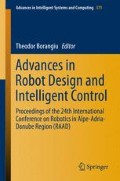Abstract
Our research aims to develop a new personalized social interaction model between a humanoid robot and an individual suffering of Autistic Spectrum Disorder (ASD), so as to enhance his/her social and communication skills. In order to define individual’s profile, we posit that the individual’s reliance to proprioceptive and kinematic visual cues will affect the way an individual suffering of ASD interacts with a social agent. We describe a first experiment that defines each participant’s perceptivocognitive and sensorimotor profile with respect to the integration of visual inputs, thanks to the Sensory Profile questionnaire and an experimental set-up. We succeeded to form 3 groups with significant different behavioural responses inside our subject pool formed by 7 adults and 6 children with ASD. In a second experiment, we presented the Nao robot to all of our participants. We video-analysed their behaviours and compared them to the profiles we defined. In view of our results, this first interaction confirmed our hypothesis: participants with a weak proprioceptive integration and strong visual dependency had more successful interaction than participants with an overreliance on proprioceptive input and hyporeactivity to visual cues.
Access this chapter
Tax calculation will be finalised at checkout
Purchases are for personal use only
Notes
- 1.
For confidentiality reasons, we encoded the participants’ identity: AD# for the participants from the adults care centre and CH# for the participants from the children care centre.
References
Feil-Seifer, D., Mataric, M.J.: Defining socially assistive robotics. In: 9th International Conference on Rehabilitation Robotics, pp. 465–468. IEEE (2005)
Tapus, A., Mataric, M.J., Scassellati, B.: The grand challenges in socially assistive robotics. IEEE Robot. Autom. Mag. (RAM) 14(1) (2008)
Charman, T., Swettenham, J., Baron-Cohen, S., Cox, A., Baird, G., Drew, A.: Infants with autism: an investigation of empathy, pretend play, joint attention, and imitation. Dev. Psychol. 33(5), 781 (1997)
Hart, M.: Autism/excel study. In: Proceedings of the 7th International ACM SIGACCESS Conference on Computers and Accessibility, pp. 136–141. ACM, New York (2005)
Tapus, A., Peca, A., Aly, A., Pop, C., Jisa, L., Pintea, S., Rusu, A.S., David, D.O.: Children with autism social engagement in interaction with Nao, an imitative robot—a series of single case experiments. Interact. Stud. 13(3), 315–347 (2012)
Kim, E.S., Berkovits, L.D., Bernier, E.P., Leyzberg, D., Shic, F., Paul, R., Scassellati, B.: Social robots as embedded reinforcers of social behavior in children with autism. J. Autism Dev. Disord. 43(5), 1038–1049 (2013)
Simmons, D.R., Robertson, A.E., McKay, L.S., Toal, E., McAleer, P., Pollick, F.E.: Vision in autism spectrum disorders. Vis. Res. 49(22), 2705–2739 (2009)
Gowen, E., Hamilton, A.: Motor abilities in autism: a review using a computational context. J. Autism Dev. Disord. 43(2), 323–344 (2013)
Greffou, S., Bertone, A., Hahler, E.M., Hanssens, J.M., Mottron, L., Faubert, J.: Postural hypo-reactivity in autism is contingent on development and visual environment: a fully immersive virtual reality study. J. Autism Dev. Disord. 42(6), 961–970 (2012)
Haswell, C.C., Izawa, J., Dowell, L.R., Mostofsky, S.H., Shadmehr, R.: Representation of internal models of action in the autistic brain. Nat. Neurosci. 12(8), 970–972 (2009)
Scassellati, B., Admoni, H., Mataric, M.: Robots for use in autism research. Ann. Rev. Biomed. Eng. 14, 275–294 (2012)
Salter, T., Michaud, F., Larouche, H.: How wild is wild? A taxonomy to characterize the ‘wildness’ of child-robot interaction. Int. J. Soc. Robot. 2(4), 405–415 (2010)
Dunn, W.: Sensory Profile: User’s Manual. The Psychological Corporation, USA (1999)
Brown, C., Dunn, W.: Adolescent-Adult Sensory Profile: User’s Manual. Therapy Skill Builders, Tucson (2002)
Isableu, B., Fourre, B., Vuillerme, N., Giraudet, G., Amorim, M.A.: Differential integration of visual and kinaesthetic signals to upright stance. Exp. Brain Res. 212(1), 33–46 (2011)
Baumberger, B., Isableu, B., Flückiger, M.: The visual control of stability in children and adults: postural readjustments in a ground optical flow. Exp. Brain Res. 159(1), 33–46 (2004)
Molloy, C.A., Dietrich, K.N., Bhattacharya, A.: Postural stability in children with autism spectrum disorder. J. Autism Dev. Disord. 33(6), 643–652 (2003)
Torres, E.B., Brincker, M., Isenhower, R.W., Yanovich, P., Stigler, K.A., Nurnberger, J.I., Metaxas, D.N., José, J.V.: Autism: the micro-movement perspective. Front. Integr. Neurosci. 7 (2013)
Acknowledgments
This work is supported by IdF Doctoral Fellowship France 2013, HANDICAP theme. Many thanks to G. Lerigoleur and C. Bazile. We also thank the participants, their families and the caretakers for their participation and support.
Author information
Authors and Affiliations
Corresponding author
Editor information
Editors and Affiliations
Rights and permissions
Copyright information
© 2016 Springer International Publishing Switzerland
About this paper
Cite this paper
Chevalier, P., Isableu, B., Martin, JC., Tapus, A. (2016). Individuals with Autism: Analysis of the First Interaction with Nao Robot Based on Their Proprioceptive and Kinematic Profiles. In: Borangiu, T. (eds) Advances in Robot Design and Intelligent Control. Advances in Intelligent Systems and Computing, vol 371. Springer, Cham. https://doi.org/10.1007/978-3-319-21290-6_23
Download citation
DOI: https://doi.org/10.1007/978-3-319-21290-6_23
Published:
Publisher Name: Springer, Cham
Print ISBN: 978-3-319-21289-0
Online ISBN: 978-3-319-21290-6
eBook Packages: EngineeringEngineering (R0)

